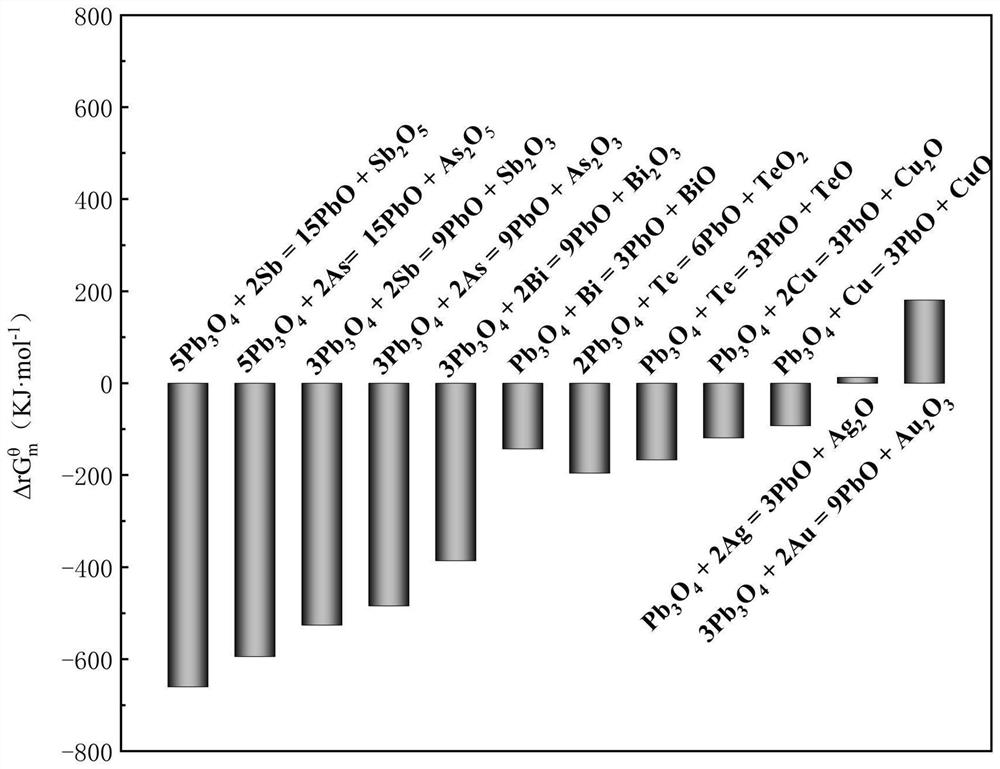Method for efficiently separating arsenic from lead anode slime through low-pressure oxidation
A lead anode slime and low pressure technology is applied in the field of high-efficiency separation of arsenic by low-pressure oxidation of lead anode slime. Effect
- Summary
- Abstract
- Description
- Claims
- Application Information
AI Technical Summary
Problems solved by technology
Method used
Image
Examples
Embodiment 1
[0026] Take 200g of lead anode slime and put it in a drying box and dry it at 120°C for 4 hours; take 50g of dried lead anode slime, add oxidant Pb 3 O 4 Grind together and put them into the crucible evenly, and put the crucible into the vertical resistance furnace; extract the air in the furnace until the pressure is stable at 10Pa, heat up to 698K, and keep the temperature for 3h. After the low-pressure gasification is completed, the first volatiles are collected at the condensing end and weighed for chemical analysis. The removal rate of arsenic was 96.84%.
[0027] Please refer to figure 2 and Figure 5 , grind the first volatile matter into a crucible, put it into a vertical resistance furnace, draw out the air in the furnace until the pressure is stable at 10Pa, heat up to 1173K, and keep the temperature for 4h. After the low-pressure gasification is completed, the second volatiles are collected at the condensing end and weighed for chemical analysis. The removal r...
Embodiment 2
[0050] Take 50g of dried lead anode slime, add oxidant Pb 3 O 4 Grind together and put them into the crucible evenly, and put the crucible into the vertical resistance furnace; extract the air in the furnace until the pressure is stable at 20Pa, heat up to 823K, and keep the temperature for 3h. After the low-pressure gasification is completed, the first volatiles are collected at the condensing end and weighed for chemical analysis. The removal rate of arsenic was 96.72%.
[0051] Grind the first volatile matter and put it into a crucible, put it into a vertical resistance furnace, extract the air in the furnace until the pressure is stable at 20Pa, heat up to 1173K, and keep the temperature for 4h. After the low-pressure gasification is completed, the second volatiles are collected at the condensing end and weighed for chemical analysis. The removal rate of arsenic was 98.77%, and the direct yields of gold and silver obtained in the residual area were 96.21% and 97.83%, re...
Embodiment 3
[0053] Take 50g of dried lead anode slime, add oxidant Pb 3 O 4 Grind together and put them into the crucible evenly, put the crucible into the vertical resistance furnace; extract the air in the furnace until the pressure is stable at 10Pa, heat up to 798K, and keep the temperature for 3h. After the low-pressure gasification is completed, the first volatiles are collected at the condensing end and weighed for chemical analysis. The removal rate of arsenic was 96.91%.
[0054] Grind the first volatile matter and put it into a crucible, put it into a vertical resistance furnace, draw out the air in the furnace until the pressure is stable at 10Pa, heat up to 1273K, and keep the temperature for 4h. After the low-pressure gasification is completed, the second volatiles are collected at the condensing end and weighed for chemical analysis. The removal rate of arsenic was 99.11%, and the direct yields of gold and silver obtained in the residual area were 97.77% and 98.52%, respe...
PUM
 Login to View More
Login to View More Abstract
Description
Claims
Application Information
 Login to View More
Login to View More - R&D
- Intellectual Property
- Life Sciences
- Materials
- Tech Scout
- Unparalleled Data Quality
- Higher Quality Content
- 60% Fewer Hallucinations
Browse by: Latest US Patents, China's latest patents, Technical Efficacy Thesaurus, Application Domain, Technology Topic, Popular Technical Reports.
© 2025 PatSnap. All rights reserved.Legal|Privacy policy|Modern Slavery Act Transparency Statement|Sitemap|About US| Contact US: help@patsnap.com



